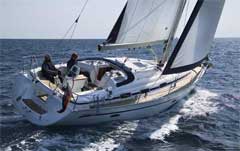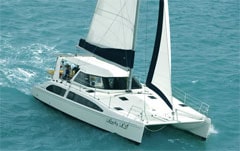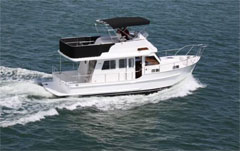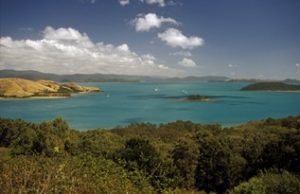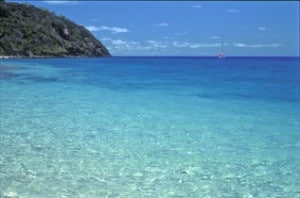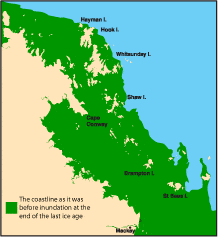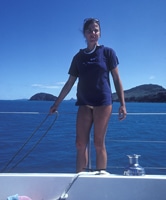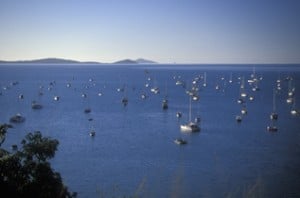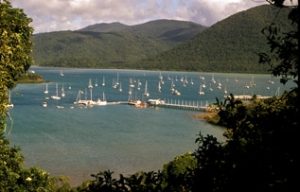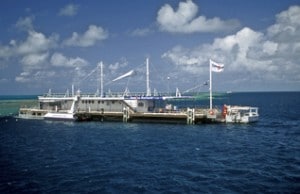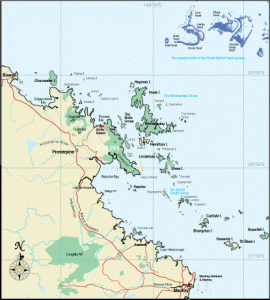The Whitsundays are perhaps most renowned for game fishing. It is Australia’s prime bill-fishing area, and during the spring and summer months game fishermen come from around the world in hopes of catching a record sailfish, or perhaps a black marlin or bluefin tuna. Over the years many light-tackle records have fallen in the Whitsundays. Amateur anglers do not require a fishing licence in Queesland, although it is unlawful to sell fish without a permit.
Please be aware that there are strict marine parks zoning rules that apply to fishing in the area. See 100 Magic Miles for zoning maps.
Reef fishing
Coral reef fishing is the preoccupation of local fishermen and can be done almost anywhere among and between the islands (other than in no-fishing zones). For those inexperienced at fishing around coral, there are a few tricks that may improve one’s luck. Fishing in coral requires line of at least a 25-kilogram breaking strain, not so much because a huge fish is waiting to pull you out of the dinghy but because coral is murder on fishing gear. Always have plenty of spares on hand. Thin line will, in short order, be chewed to pieces by coral, and fish living around coral tend to take the bait and run for cover under the nearest boulder. A line attached to a fleeing fish can be quickly severed, and it may also cut the fingers, which is why many coral fishermen tape their finger joints. Keep enough tension on the line to register bites and to avoid snagging. The weight of sinker can be adjusted to suit the current.
Fish over the edge of the reef one hour before or after high tide for best results (neap tides are better): early morning and evening are also better than when the sun is high. Night-time on a rising tide can be excellent. Trolling along the edge of a reef may also produce dividends.
Baits readily available in the Whitsundays are prawns, squid, Western Australian pilchards, small fish known locally as ‘herring’ and garfish. If you have a throw-net, small fresh fish from the shallows make excellent bait. A few suggestions about tackle are given later.
Estuary fishing
The Whitsunday mainland coast is studded with mangrove inlets that can yield good catches, and on some of the larger islands, such as Whitsunday and Hook, there are deep embayments with mangrove areas that also can reward the angler. As the tide runs out of estuaries and creeks, predator fish look for baitfish that hide around sheltering ‘snags’ or which are being flushed from streams and gutters on the flats and out into the main creek. During the last half of the runout and the first part of the rising tide these areas can be a good place to drop a lure or a live bait. Some of the bigger fish hang around the deeper holes and channels.
Where best to fish for reef and estuary species
This is the million dollar question, and regard with suspicion any ‘hot tips’ that are other than pretty general in nature. It is impossible to pinpoint exact locations both because these are constantly changing but also because one can easily be a matter of metres off the right place – for example, a particular deep hole. Professional fishermen take years to locate productive fishing spots, and even when they think they know where to go, they often find that they have to keep moving to find the fish. Good spots go cold; months later they may become productive again. Some general locations that are popular with amateurs and which usually yield results are:
- The Maze: located at the southern end of the Stepping Stones, this dive site is literally a maze of canyons, caves and crevices and relatively shallow (5-15 metres). Large fish are often found in the caves and under ledges. Angelfish are also common. Minimum current within the maze;
- Hawaii: this large solitary Stepping Stone is located near the northern end of the chain. It drops to nearly 20 metres on the seaward side. Plenty of big fish life but also plenty of current at mid-tide;
- Cluster of Four: as the name implies, four medium-sized stones in close proximity have created some excellent terrain for exploring – deep canyons and narrow crevices full of whip corals and large fish life. Some current on outside.
- The Lost Stone: at the northern end of the chain, the stones seem to disappear but are actually just deeper, rising to within 5 metres of the surface. Very good fish life, medium- to large-sized. Fairly deep dive, 8-30 metres. Current at mid-tide.
Game fishing
The Whitsundays are a renowned game-fishing area, particularly for billfish. Game-fishing charter boats operate from the mainland and from several of the islands.
In the winter months, the Whitsunday’s experience big runs of Spanish mackerel -beginning mid to late May and running until late September or early October, although mackerel can caught any time of year.
In summer, the Whitsundays are a prime billfish area – black marlin, swordfish, sailfish – and tuna are caught in large numbers from October through April, although the latter may also be caught year round. Tournaments are held throughout the year for a number of different species, with major meetings in November and December in quest of billfish.
Game fishing takes place around the islands and out at the Barrier Reef (weather permitting). Mackerel can be caught anywhere, but the best locations are the outlying islands from Deloraine, the Edward Group, Minstrel Rocks, around past Pinnacle Point at the top of Hook Island to Dolphin Point, Hayman Island. ‘The Paddock’, which is the open water just north-east of Hayman and Hook islands, yields some magnificent game fish.
Tuna can be caught right amongst the islands. Experienced anglers look for birds diving on the water, a sure sign in season that there are tuna. One tactic employed for hooking tuna is to run just upwind of the feeding school and cast across and through the school with a spinning outfit, such as a small chrome spinner with treble hooks hanging off the back. This tactic avoids ‘spooking’ the fish, which sometimes happens when trolling around tuna. Run upwind, which will facilitate casting, and shut down the motor: in this way its possible to get within 6-10 metres.
Bilifish are found in the shipping channel, between the islands and the Great Barrier Reef, in deep water where there are lots of bait fish in the summer months. Marlin range in size from 10 to 125 kilograms, the average being 30 to 50 kilograms.
The great majority of billfish caught in the Whitsundays are tagged and released.
Rigs for fishing coral reefs, estuaries and for trolling
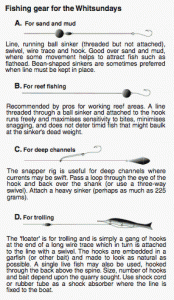
A rod may have its advantages when fishing from rocks on the mainland, but hand lines are easier to manage on a boat A large diameter casting reel makes hand-line management much easier.
The illustration represents the most popular rigs with local fishermen. A, B and C may all be used for reef or estuary fishing, for bottom fishing over sand, mud, near bommies or around reefs. A and B are preferred in reef fishing as they are light: the important basic principle in all rigs is to use the minimum amount of wire trace, the smallest number of swivels and the lightest possible sinker. Too much hardware makes it difficult to register bites and increases the risk of the line being snagged on coral or some other obstruction. Running sinkers (through which the line can easily pass) help timid fish to go with the bait without having to drag a weight that might otherwise deter them. Some fishermen prefer beanshaped sinkers instead of ball sinkers as the bean keeps the line in place more effectively. Rig A is good over sand or mud, as some movement helps to attract fish such as flathead. Rig C is sometimes called a snapper rig and is used in deep channels. The sinker may weigh as much as 225 grams. Rig D, the ‘floater’, is simply a gang of hooks (the size to be determined by the quarry sought) generally used to catch surface swimming fish such as mackerel.
Garfish is popular bait for mackerel, usually on a piece of wire 30-35 centimetres long with two or three ganged hooks run into the belly of the bait. In front of this some of the professionals use a coloured plastic squid (any bright colour will do), about 12 centimetres long, with a barrel sinker in the front end to keep it underwater when trolling at 5 knots or so. When trolling with a rig other than a rod, its a good idea to have some shock absorber in the line, perhaps a bit of bicycle tube or a shock cord tied between the line and where it is secured.
Do’s and don’ts
If you’re unfamiliar with fishing in Queensland, check out the following web site for a rundown on some do’s and don’t’s:
http://www.daff.qld.gov.au/fisheries
There are seven ‘no-take’ species of fishes, four because they are poisonous (see 100 Magic Miles, page 93), and three which are totally protected because they are endangered. These are:
- Potato cod
- Queensland groper
- Hump-headed Maori wrasse

Above: Potato Cod

Above: Queensland Groper

Above: Hump-headed Maori Wrasse
Fishing is prohibited in Marine National Park zones (green areas).
In Conservation Park zones (yellow), fishing is permitted with the use of only one hook on one hand-held line or rod (per person); no set lines are permitted. Trolling for pelagic fishes is allowed.
Spear fishing
Limited spearfishing is allowed in the General Use (light blue), Habitat Protection (dark blue) and Conservation Park (yellow) Zones and means fishing with a spear or speargun not using a powerhead, a firearm, a light, or underwater breathing apparatus other than a snorkel. It. Spearfishing in yellow zones that lie within Public Appreciation Areas is not permitted (see 100 Magic Miles pages 112–113 for zoning information). Public Appreciation Areas are shown as broken pink lines on the zoning map. A person must not have a loaded speargun in his or her possession out of the water.
Spear guns and spears may only be used by persons aged 15 years. Power heads are not permitted. Spear fishing is totally prohibited in all Marine National Park zones and in the following areas in the Whitsundays:
- Brampton and Carlisle Islands: waters between the islands.
- Seaforth Island.
- Lindeman Island: the western and southern sides.
- Long Island: the western side.
- South Molle Island: the northern side.
- West Molle Island (Daydream Island): surrounding waters.
- Hook Island: the eastern, south eastern and southern sides.
Seasonal restictions, legal sizes and bag limits
Fishing is an extremely popular recreation in the Great Barrier Reef Marine Park as well as an important commercial activity and, to protect a seriously diminishing resource, some restrictions, including minimum and maximum size limits and bag limits (maximum number taken), have had to be implemented for species that are under heavy pressure from fishing. Check that you have the latest information on size and bag limits:
http://www.daff.qld.gov.au/fisheries
Coral reef fin fish
The Queensland Government has announced the Coral reef fin fish closed season dates for the next five years which will provide certainty and long-term planning for fishers. Dates in advance assist fishers in their planning.
The closure dates are:
| Year |
Closure 1 |
Closure 2 |
| 2014 |
21 October to 25 October |
19 November to 23 November |
| 2015 |
10 October to 14 October |
9 November to 13 November |
| 2016 |
28 October to 1 November |
26 November to 30 November |
| 2017 |
17 October to 21 October |
15 November to 19 November |
| 2018 |
6 October to 10 October |
5 November to 9 November |
The closure dates coincide with the new moon when key coral reef fish species aggregate to spawn. The dates have been scientifically reviewed, and October and November have been found to be the months of highest effectiveness for closures to protect coral reef fin fish.
Closed seasons are vital to allow stocks to replenish to ensure there are healthy fish stocks for current and future generations of Queensland fishers.
The closures apply to coral reef fin fish only, so fishers can still enjoy fishing for a wide range of other fish during the closure period.
The closures will be in place from the northern tip of Cape York to Bundaberg in the south (the southern boundary is at latitude 24º 50’S). The eastern boundary of the closure is the same as the eastern boundary of the Great Barrier Reef Marine Park.
Purpose of size and bag limits
The purpose of minimum size limits is to protect fish until they grow to maturity and can have at least one spawning cycle. Maximum size limits have been introduced to protect large groper and cod. Any fish falling outside the size limits must be released. Bag limits help to conserve heavily exploited species and spread the catch more equitably among fishers.
Anglers are not supposed to mutilate any fish so that the fish inspector can’t determine what’s been caught. If fish are filleted, skin must be left on. Fisheries inspectors make regular checks of vessels, and the penalties are quite heavy for possession of undersized or too many fish.
Oysters
Oysters may be taken only for immediate consumption on the spot in most of the Whitsundays, except in the totally protected Marine National Park zones where they may not be taken at all. Under Queensland fisheries legislation you may not collect oysters in a container to eat later.
Identifying your fish
The best way to identify fish caught in the Whitsundays is to ask a local fisherman. Some assistance may also be found in two very good books on fishes of Queensland and the Barrier Reef region, Guide to Fishes, by E.M. Grant, and Fishes of the Great Barrier Reef and Coral Sea, by J. Randall, G. Allen and R. Steene.
Fish poisoning
There are a few fishes in Queensland which are known to cause tropical fish poisoning (ciguatera) and which should not be eaten:
- Chinaman fish
- Paddle tail
- Red bream (see 100 Magic Miles page 93 to identify these)
- Barracouta
- Moray eel.
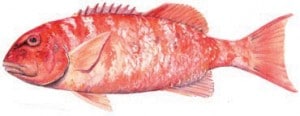
Above: Chinaman Fish
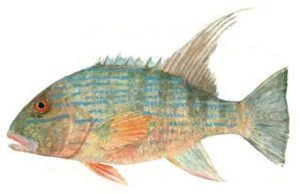
Above: Juvenile Chinaman Fish
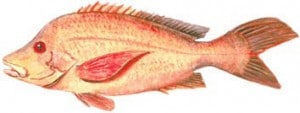
Above: Paddletail
It’s a good idea to check locally to see that others have not been put on the list temporarily (fish can become temporarily ciguatoxic in a particular locality). Generally, larger fishes are more likely to be ciguatoxic. Avoid eating any fish larger than 4 kilograms, and don’t eat repeated meals from the same large fish. Puffer fishes are inherently poisonous and should never be eaten.
Get this information and more in the latest edition of 100 Magic Miles of the Great Barrier Reef – The Whitsunday Islands, or pick up a copy of The Whitsundays Book
Fishing Trip Operators


